Scott Hamilton – 19 March, 2019
The Museum, with its ethic of preservation, cannot do its duty to kulap sculptures, to the souls they house. Just as undertakers are repulsed by a decomposing body, so curators recoil from the fate of fragile artefacts. Formaldehyde and glass cases are forms of denial.
I look at the kulap, which was carved to house spirits of the recently dead, and made to be smashed after a few months’ mourning, but which has been preserved for a hundred and forty-two years in Auckland War Memorial Museum, and I think of my grandmother, who took a decade to die of dementia.
Like the soul that the kulap perhaps imprisons, my grandmother was locked in a useless vessel. Like the soul in the kulap, she waited hopelessly, under white lights, an artefact exhibited for visitors to her institution. Is the urge to preserve a destructive urge?
New Ireland, a large island in Papua New Guinea, is shaped like a musket. Kulap sculptures come from the island’s southeast, the handle of the gun. When a member of his family died, a man from one of the southeast’s coastal villages trekked inland, toward the island’s mountains, where seams of limestone emerge like bones from gangrenous jungle. He found a carver, and together they chose a seam.
The sculpture was carried home, and placed in a house of the dead, a squat thatched hut, where it conversed with other kulaps. Men were allowed into the hut, to dance for the amusement of the dead. Women had to mourn outside. After a few months, and a few dances, the kulap was smashed.
In the second half of the nineteenth century traders and missionaries invaded New Ireland. The Reverend George Brown, a Wesleyan fond of ethnographic studies and holy wars, began to convert souls from coastal communities, and steal the souls he found in kulap figures.
In 1877 Brown sent three New Ireland sculptures—two kulaps carved from limestone, and a small chalk frog—to his friend Thomas Cheeseman, the curator of Auckland War Memorial Museum, which was then a cottage with a view of an open sewer on Princes Street. Along with the soul-holders, Brown despatched a box he had filled with bones in New Britain and in the Duke of York Islands, which sit between New Britain and New Ireland. Brown collected artefacts as obsessively as converts, as he moved from one island to another. The items he sent to Auckland may have been swapped for axeheads or other exotic objects, or bought with the shell currency of New Guinea’s islands.
In 1878, a year after his gift to the people of Auckland, Brown assembled a Christian army, and raided his way along the east coast of New Britain, where pagans had been cannibalising his emissaries. Brown would anchor his sailboat off a village, send his men ashore, and wait for smoke to rise through the jungle. Brown’s soldiers plundered before they burned, and the spoils of his war became ethnographic treasures.
When Auckland War Memorial Museum relocated to the green extinct volcano of Pukekawa, and was given Greek pillars and soundproof marble vaults, the imprisoned souls moved too. Today the kulap figures are displayed reverently. Dust mites are wiped from their brows, finger grease from their glass cases. Cameras flash at them like musket barrels.
The kulap is one of six hundred exhibits in the Pacific Masterpieces gallery. In this room on the Museum’s ground floor, objects once separated by seas and mountains and taboos confront one another. A feather cloak from Hawai’i puffs out its chest at a phalanx of shields torn from warriors of Enga; a mask carved in the swamp delta of the Sepik peers at a necklace of shark’s teeth unearthed on a Micronesian atoll. In the middle of the gallery a vaka from Tikopia has unfurled a barkcloth sail; perhaps it hopes somehow to steer through the clutter.
Before dementia stripped the nerve endings from her brain, my grandmother wanted to leave her obsolete body and join her late husband. Perhaps, in the same way, the soul in this kulap yearns for its limestone prison to break; it longs to return to its island, its villages, its fields.
The Museum, with its ethic of preservation, cannot do its duty to kulap sculptures, to the souls they house. Just as undertakers are repulsed by a decomposing body, so curators recoil from the fate of fragile artefacts. Formaldehyde and glass cases are forms of denial.
Yet I love looking at the kulap figures. One of them gazes at me inquiringly. His hands caress each other; his tongue lazes between intricate sets of teeth. I forget about the soul that reputedly lives inside the limestone, so fascinated am I with its owner’s likeness.
In 1933, in a lunchtime lecture to a local branch of the Society of Arts, Auckland War Memorial Museum’s Gilbert Archey, who began his career studying frogs and crayfish and promoted himself, in late middle age, to ethnology, argued that Melanesian and other ‘negroid’ sculptures lack ‘individual expression’. The ‘community sense’ of Melanesian carvers was so strong, Archey said, that they turned out unvarying, anonymous figures.
Gilbert Archey was wrong. Much of the surface of kulap sculptures is smooth and blank, but each figure boasts a few, individuating details: a mouth that smiles beatifically or ingratiatingly, eyes wide with fright or slanted by fatigue, a receding hairline, protuberant ears.
Perhaps, I tell myself, this kulap was one of the artefacts manufactured for sale to European intruders, when New Ireland’s gods had gone into hiding in the jungle, and souls were being sung to heaven from churches, rather than kept in stone. Perhaps no one is imprisoned here.
Or perhaps no soul ever entered a kulap. Perhaps Papuan cosmology offers a false model of the universe and its processes, like Muggletonianism or astrology. If no soul waits here, then the kulap figure can be enjoyed as an artefact, as art. The last kulap was carved in 1910. Today in Papua, it is fundamentalist Christians, rather than heathens, who smash graven images.
In 2011 Peter O’Neill, Papua New Guinea’s thuggish but wily Prime Minister, proclaimed that every August the 26th his people would hold a National Day of Repentence, when they would pray for their future and regret the evils of their past. Every August the 26th since then, the most pious Papuans have made bonfires from their ancestors’ carvings.
In 2013 Theo Zurenuoc attacked several carvings in Papua’s Parliament, complaining that they were demonic. Zurenuoc was Parliament’s Speaker. For fundamentalists like him, Papua’s misfortunes—its corruption, crime, and leaking mines—are the work of satanic carvings, like the kulap figures from New Ireland. Zurenuoc proposes installing the King James Bible in his nation’s parliament, in place of carved demons.
In 2015 a 1611 edition of the King James Bible was welcomed by twenty thousand Papuans gathered at Port Moresby’s airport. Many of them had read a recently published booklet called Tear Down the Idols: a call to the people of PNG to destroy all idolatrous objects, and had acted on its advice.
Perhaps Auckland Museum is a sanctuary for kulap figures and other threatened treasures from the pagan past threatened by Zurenuoc and his ilk. The Museum’s curators, with their love for their amulets, gods, and soul-vessels, might be substitute priests.
Sometime early this century Roger Neich, Auckland Museum’s veteran ethnologist, was queuing in his institution’s bookshop when he noticed that the young man in front of him was buying one of his publications. Neich introduced himself to Visesio Siasau, and offered to show the Tongan sculptor the carved weapons and deities in the museum storerooms, refugees from nineteenth century Tonga’s Wesleyan fires. Neich became a mentor to Siasau, and a door to Tonga’s pagan past. The ethnologist’s essay about Tonga’s carved goddesses, which runs to sixty-six pages, attains the intensity of devotional literature, as it describes the contours of sacred wooden bodies, and laments their desecration by flames and knives.
I stepped into Neich’s office once, near the end of his life. The scholar was absent, eating a sandwich in the Museum’s cafeteria, but a Tongan goddess glared at me from the desk with the disapproving look a busy administrator inflicts on an unscheduled visitor.
I wanted these notes to clarify my feelings about the kulap in Auckland Museum, a figure that has entered my dreams. However I cannot resolve my attitudes toward the sculpture. I want to destroy and preserve it, forget and revere it.
Scott Hamilton
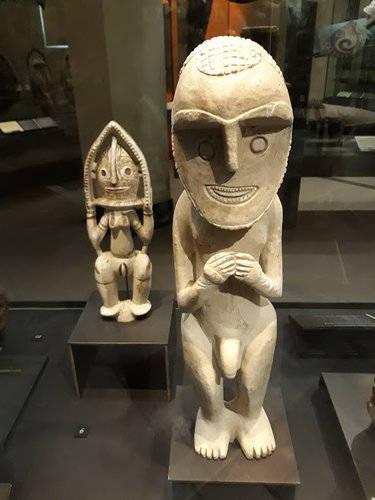
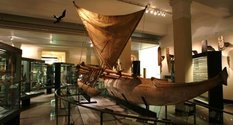
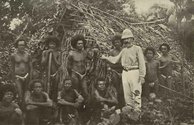

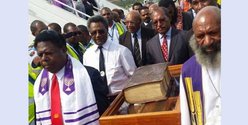
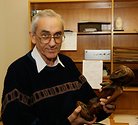
 Two Rooms presents a program of residencies and projects
Two Rooms presents a program of residencies and projects Advertising in this column
Advertising in this column



This Discussion has 0 comments.
Comment
Participate
Register to Participate.
Sign in
Sign in to an existing account.